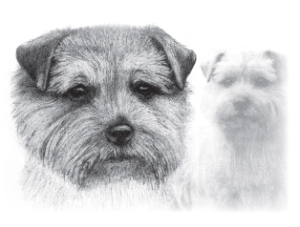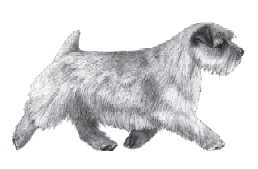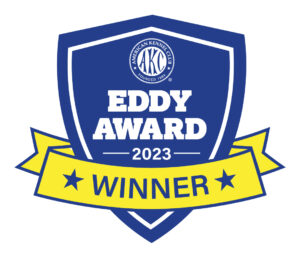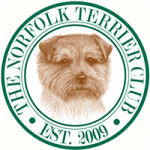Breed Standard
Official Standard of the Norfolk Terrier
General Appearance: The Norfolk Terrier, game and hardy, with expressive dropped ears, is one of the smallest of the working terriers. It is active and compact, free-moving, with good substance and bone. With its natural, weather-resistant coat and short legs, it is a "perfect demon" in the field. This versatile, agreeable breed can go to ground, bolt a fox and tackle or dispatch other small vermin, working alone or with a pack. Honorable scars from wear and tear are acceptable in the ring.
Size, Proportion, Substance: Height at the withers 9 to 10 inches at maturity. Bitches tend to be smaller than dogs. Length of back from point of withers to base of tail should be slightly longer than the height at the withers. Good substance and bone. Weight 11 to 12 pounds or that which is suitable for each individual dog's structure and balance. Fit working condition is a prime consideration.
Head: Eyes small, dark and oval, with black rims. Placed well apart with a sparkling, keen and intelligent expression. Ears neatly dropped, small, with a break at the skull line, carried close to the cheek and not falling lower than the outer corner of the eye. V-shaped, slightly rounded at the tip, smooth and velvety to the touch. Skull wide, slightly rounded, with good width between the ears. Muzzle is strong and wedge shaped. Its length is one-third less than a measurement from the occiput to the well-defined stop. Jaw clean and strong. Tight-lipped with a scissor bite and large teeth.
Eyes small, dark and oval, with black rims. Placed well apart with a sparkling, keen and intelligent expression. Ears neatly dropped, small, with a break at the skull line, carried close to the cheek and not falling lower than the outer corner of the eye. V-shaped, slightly rounded at the tip, smooth and velvety to the touch. Skull wide, slightly rounded, with good width between the ears. Muzzle is strong and wedge shaped. Its length is one-third less than a measurement from the occiput to the well-defined stop. Jaw clean and strong. Tight-lipped with a scissor bite and large teeth.
Neck, Topline, Body: Neck of medium length, strong and blending into well laid back shoulders. Level topline. Good width of chest. Ribs well sprung, chest moderately deep.
Strong loins. Tail medium docked, of sufficient length to ensure a balanced outline. Straight, set on high, the base level with the topline. Not a squirrel tail.
Forequarters: Well laid back shoulders. Elbows close to ribs. Short, powerful legs, as straight as is consistent with the digging terrier. Pasterns firm. Feet round, pads thick, with strong, black nails.
Hindquarters: Broad with strong, muscular thighs. Good turn of stifle. Hocks well let down and straight when viewed from the rear. Feet as in front.
Coat: The protective coat is hard, wiry and straight, about 11⁄2 to 2 inches long, lying close to the body, with a definite undercoat. The mane on neck and shoulders is longer and also forms a ruff at the base of the ears and the throat. Moderate furnishings of harsh texture on legs. Hair on the head and ears is short and smooth, except for slight eyebrows and whiskers. Some tidying is necessary to keep the dog neat, but shaping should be heavily penalized.
Color: All shades of red, wheaten, black and tan, or grizzle. Dark points permissible. White marks are not desirable.
Gait: Should be true, low and driving. In front, the legs extend forward from the shoulder. Good rear angulation showing great powers of propulsion. Viewed from the side, hind legs follow in the track of the forelegs, moving smoothly from the hip and flexing well at the stifle and hock. Topline remains level.

Approved October 13, 1981
Reformatted March 23, 1990
Link to the Illustrated Standard Published by the NTC

